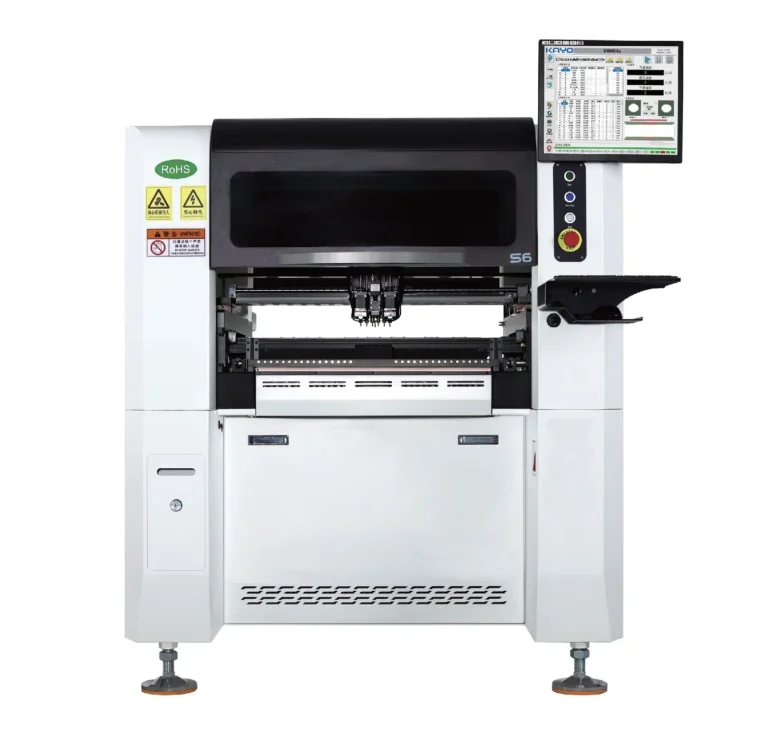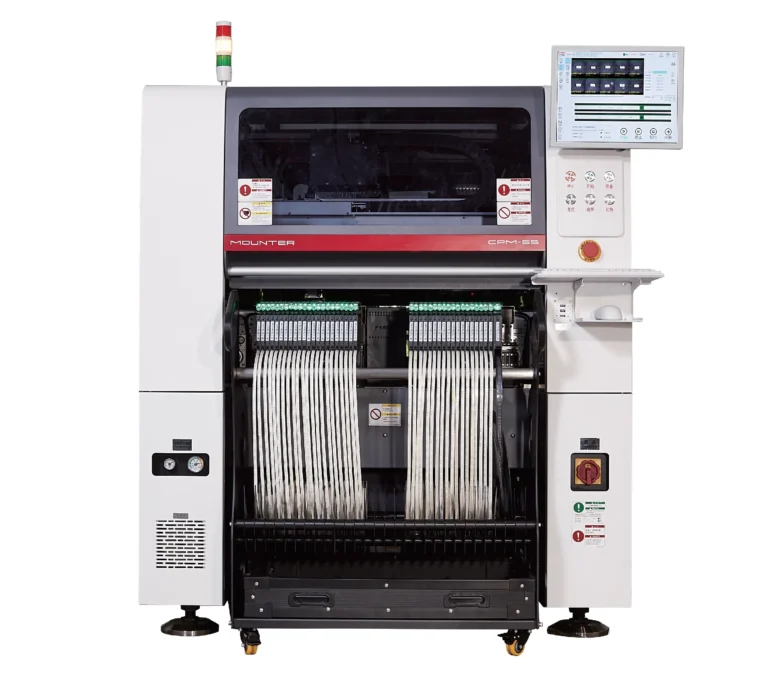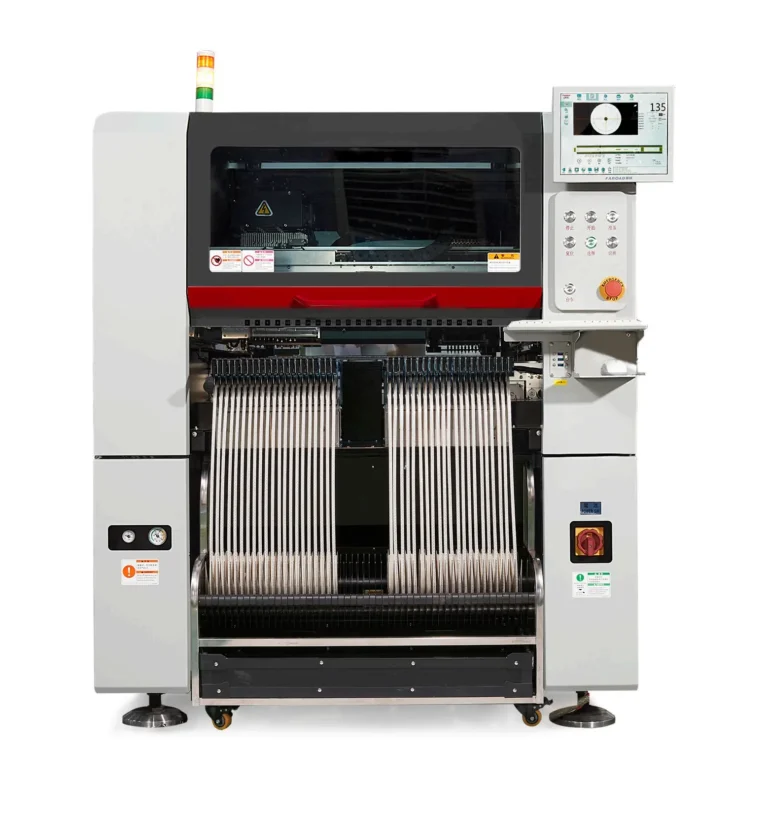Understanding SMT Pick-and-Place Machines

SMT pick and place machine is an automated device specifically designed for the precise placement of surface mount devices (SMD) on printed circuit boards (PCB). It is the core equipment of the SMT production line, accounting for about 50% of the total production line cost. By utilizing high-speed robotic arms, vision positioning systems, and feeders, it achieves the functions of component grabbing, positioning, and placement, directly influencing production efficiency and product quality.
The typical workflow involves several key steps:
- Identification and Reading: After the machine starts, it first identifies the alignment marks (Fiducial Mark) on the PCB through a vision system (usually a camera), helping to calibrate the position of the PCB.
- Component Supply: The feeders automatically supply components, arranged in a specific order for picking.
- Component Picking: The nozzle on the robotic arm moves to the feeder’s position and uses vacuum suction to pick up the components.
- Placement: The robotic arm moves the components to the specified position on the PCB and places them with precise Z-axis control.
- Inspection and Feedback: After placement, the machine performs an initial check to inspect the position, angle, and height of the components to ensure compliance with preset requirements.
Pick and place machine hot style

HW-A6L PCB Pick and place Machine
Dual-arm combined placement enables the fastest placement speed of 84,000 CPH (under our optimal conditions).
The dual-arm dual-drive system effectively ensures precision and consistency during high-speed operation.

HW-S6 SMD Pick-and-place Machine
Six heads can pick simultaneously, maintaining the same distance as the feeders. It supports simultaneous material pick-up from 8mm feeders on both the front and back fixed plates. The nozzle stroke is 31mm, and it can place components with a height of up to 14mm.

HW-S5 High-precision Automatic Pick-and-place Machine
Dual-arm combined placement enables the fastest placement speed of 84,000 CPH (under our optimal conditions).
The dual-arm dual-drive system effectively ensures precision and consistency during high-speed operation.

HW-F5 Multi-Functional Automatic Pick-and-place Machine
High-Efficiency Integrated Placement Head Configuration (Quick and Easy Setup)
Peak Performance: 42,000 CPH (Under Optimal Conditions)
Component Compatibility: Supports tiny 0201 chips to large components up to 40mm × 40mm

HW-A8 Automatic Pick-and-place Machine for LED
Discover the high-performance HW-A8 SMT placement machine featuring 8 industrial vision cameras, Panasonic servo drives, and granite stability platform. Achieve ±0.05mm accuracy with 40K CPH speed for LED strips, bulbs, drivers & more. Professional-grade SMT solution with 360° placement capability.
Main Types of Classification
- By Production Scale
- Entry-Level: Suitable for small batches or research and development, such as desktop models (like Neoden series), with low cost but slow speed.
- Mid-Range Models: Suitable for medium-sized enterprises, balancing speed and precision (such as HW-F5 Pick-and-place Machine).
- High-End Models: Used for large-scale mass production, supporting ultra-high speed (>40,000 CPH) and multiple types of components (such as HW-A6L/HW-S6/HW-S5).
- By Functional Features
- High-Speed Pick-and-Place Machines: Specifically designed for the high-speed placement of single components (such as HW-S5/S6).
- Multi-Functional Pick-and-Place Machines: Supports irregular components (like connectors, BGA), providing high flexibility (such as HW-F5 Multi-Functional Automatic Pick-and-place Machine).
- Online Systems: Integrated into fully automated SMT lines, in linkage with printers and reflow soldering.
- By Structural Form
- Turret Type: High speed but low flexibility (such as Panasonic CM series).
- Arch Type: Mostly used in multi-functional models, high precision but slightly slower (such as Universal Instruments).
How to Choose the Right SMT Pick-and-Place Machine
1. Clarify Production Needs
- Production Scale
- Small Batch Production: It is suitable to choose flexible and easy-to-operate mid-range or entry-level pick-and-place machines (such as domestic equipment).
- Medium Batch Production: Requires pick-and-place machines that balance speed and precision (such as Yamaha YSM series).
- Large Batch Production: Prioritize selecting high-speed and high-precision high-end pick-and-place machines (such as Fuji NXT, Siemens Siplace).
- Component Types
- If primarily placing small components (like 0201, 0402), choose high-speed pick-and-place machines.
- If there is a need to place irregular components (like connectors, BGA), choose multi-functional pick-and-place machines (like JUKI RS series).
- Production Efficiency
- Calculate the number of components needed to place per hour (CPH, Component Per Hour), and choose equipment that matches that placement speed.
- Board Size
- Ensure that the pick-and-place machine’s maximum board size can meet current and future needs.
2. Choose the Right Type of Pick-and-Place Machine
- By Functional Classification
- High-Speed Pick-and-Place Machines: Suitable for the rapid placement of single components (like resistors and capacitors).
- Multi-Functional Pick-and-Place Machines: Supports various component types, suitable for complex circuit boards.
- Online Pick-and-Place Machines: Integrated in fully automated SMT production lines, suitable for large-scale production.
- By Structural Classification
- Turret Type Pick-and-Place Machines: High speed but less flexibility, suitable for standardized production.
- Arch Type Pick-and-Place Machines: High flexibility, suitable for various products and small batch production.
3. Focus on Equipment Performance Indicators
- Placement Speed (CPH)
- High-speed pick-and-place machines: >40,000 CPH (e.g., Fuji NXT).
- Mid-speed pick-and-place machines: 10,000-40,000 CPH (e.g., Yamaha YSM).
- Entry-level pick-and-place machines: <10,000 CPH (e.g., Chinese equipment).
- Placement Accuracy
- Positional Accuracy (Absolute Accuracy): The deviation of placement position, typically ±5-±10 μm.
- Repeat Accuracy: The deviation of multiple placements, typically ±3-±5 μm.
- Resolution: The precision of the placement head’s rotation angle.
- Component Usability Range
- Ensure the pick-and-place machine supports the required component sizes (like 0201, 0402, BGA, etc.).
- Software System
- Choose software systems that support intelligent programming, data processing, and production management, enhancing the ease of use and efficiency of the equipment.
- Other Technical Features
- Dual Y-Axis Drive: Enhances the stability of high-speed placements.
- Thermal Compensation Function: Reduces the impact of temperature variations on accuracy.
- CPK Inspection Support: Validates the long-term stability and accuracy of the pick-and-place machine.
- Automatic Nozzle Change: Enhances efficiency for multi-component placements.
4. Choose Well-Known Brands
- Global Brands
- Fuji (Japan): Known for the NXT series, high-speed and precision, suitable for mass production.
- Siemens (Germany): Siplace series is renowned for its intelligence and flexibility, supporting complex components.
- Panasonic (Japan): CM series turret-type equipment, speed leading.
- Yamaha (Japan): YSM series offers a high cost-performance ratio, suitable for medium-sized enterprises.
- JUKI (Japan): RS series performs excellently in multi-functional models.
- ASM (Germany): SIPLACE series emphasizes modular designs, providing strong adaptability.
- Mycronic (Sweden): Focuses on high-precision placement, suitable for micro components.
- Hanwha (South Korea): Strong price competitiveness, covering the mid-to-low-end market.
- Chinese Brands
- Topkey: High cost performance, suitable for small and medium batch production.
- Steker: Good stability, supports a variety of placement needs.
- Guangshengde: Excellent performance in accuracy and speed, suitable for high cost-performance needs.
5. Evaluate After-Sales Service
- Repair and Maintenance
- Choose manufacturers that provide comprehensive after-sales services, including regular maintenance, fault repair, and spare parts supply.
- Training Support
- Ensure the manufacturer provides operational training and technical support to help employees get up to speed quickly.
- Warranty Period and Resale Value
- A long warranty period and high resale value are important guarantees for equipment investment.
6. Budget and Cost Performance
- Imported Pick-and-Place Machines
- Stable performance and reliable quality, but relatively high priced, suitable for high-end production needs.
- Domestic Pick-and-Place Machines
- High cost-performance ratio, suitable for small to medium batch production or scenarios with lower precision requirements.
- Second-Hand Pick-and-Place Machines
- If the budget is limited, consider buying second-hand imported pick-and-place machines, but ensure that the equipment is in good condition and regularly maintained.
